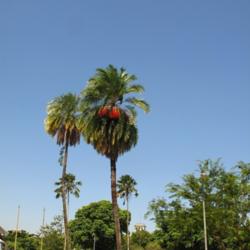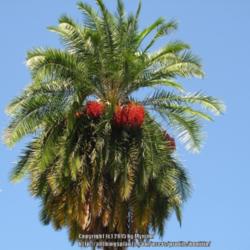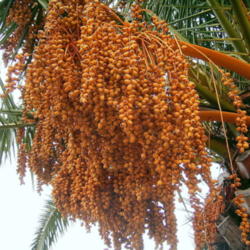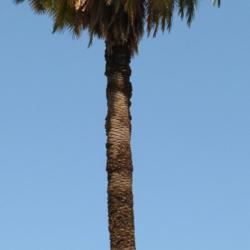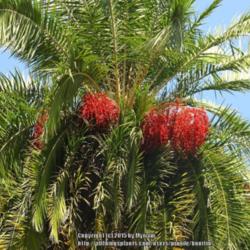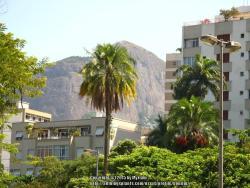Are you sure that photo on pinterest is Phoenix dactylifera Myriam? I checked the wording on the photo by hovering the arrow over it, and clicked the 'more' link below, it doesn't say where it is.
I didn't expand the description, but the diamond shaped leaf scars look more like stubs to me than the criss-crossing effect. It's an African species.
http://www.florafinder.com/Spe...
The description also says:
As an ornamental plant, it is however less attractive than many other palms, with sparser, more rigid foliage (less graceful) than the related Canary Island Date Palm Phoenix canariensis.
This site is from Brazil, I translated the words ..
http://www.mfrural.com.br/mobi...
Date Palm Palm tree has single or branched stem at the base, with a height up to 30.0 meters in their places of origin.
In its height is around 15 to 18.0 metres.
Your World Cup can take good space, about 6.0 metres when in adulthood, with large number of leaves, around 20 to 40 units.
Its trunk is wide and can reach up to 45 cm in diameter and is covered with small scraps of fallen leaves, giving a scaly appearance.
These remains of leaves are dry and grey in colour.
The leaves are large, reaching to 3 to 6 meters long by 30 to 60 cm wide at the base.
The new leaves are erect, arching itself over time.
Their general appearance is similar to that of Phoenix canariensis, but this can achieve only 21.0 metres and its Crown of leaves is with approximately of 100 units per change.
The flowers are white, produced in female flowers and yellow in the male, which are on separate plants, as it is a dioecious Palm.
The large bunches of flowers produce edible yellow frutinhos and greatly appreciated.
Several Mediterranean countries grow date palms, as Spain sell the fruits in the form of raisins for savory and sweet recipes.
The company is on the market for almost 30 years producing and selling seedlings and native plants, fruit trees, Ornamentals and palms. Our concern is the choice of the seed, the soil preparation, seed germination, planting, extraction, bleeding, transport and replanting. For a higher quality all stages are accompanied by agricultural technicians. This brings us the security of always be offering a product of the highest quality and guarantee. Our company is qualified to meet all types of customer, we have to prompt delivery from seedlings in bags to trees and palm trees and fruit adult already producing fruit in the foot.
With orange fruits ..
http://produto.mercadolivre.co...
Adaptation in Brazil ..
https://translate.google.be/tr...
The date palm was introduced in Brazil for many years but there were few systematic studies of this culture. The first record of introduction of date palm in Brazil dates back to 1928 when some materials were introduced in São Paulo and some studies have been conducted in the Escola Superior de Agricultura Luiz de Queiroz, which originated some varieties.
In northeastern Brazil the date palm was introduced in public irrigation projects, however very little information about the culture were collected, although it is known that it was in this region where the plants showed more promising results.
In the early eighties, the Agricultural Research Center Tropic Semi-Arid and the National Center for Genetic resources, both from Embrapa, introduced palm trees originating in Africa and the United States, whose plantations were installed in the Bebedouro Experimental Station in Petrolina -PE. A large part of these plants were originated from seeds, resulting in a large number of individuals with different genetic characteristics as the original variety, however, another group of plants from shoots, have the genetic traits of the original variety.
A scientific Brazilian site which says it's more adapted to hot, arid areas such as north east Brazil ..
The date palm (Phoenix dactylifera L.) is a kind of arecaceae family that produces highly nutritious edible fruit and is of considerable importance to many countries in North Africa, the Middle East and East Asia. Due to its botanical characters and their development capability in hot and arid regions and in various types of soils, the date becomes a great option for the Brazilian Northeast.
https://translate.google.be/tr...
A photo showing the chunky diamond shaped leaf scars well, you can enlarge it ..
https://translate.google.be/tr...
